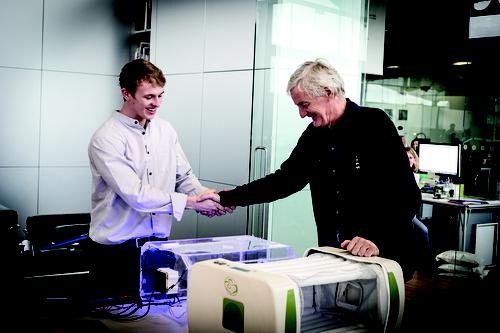Inexpensive Incubator Tops Dyson Awards
November 11, 2014

James Dyson has chosen the winner of his international design competition for engineering students. The James Dyson Award is an international competition that challenges students to design a product that solves a problem. This year's competition attracted 600 entries from around the world.
More than one in 10 babies worldwide are born prematurely; the leading cause of newborn death. This year's Dyson Award winner, James Roberts -- a recent graduate of Loughborough University in England -- created the MOM incubator to solve the problem of insufficient incubation in developing countries. MOM is an inexpensive inflatable incubator that runs off a battery which lasts 24 hours, in case of power outages. The incubator is blown up manually and it is heated using ceramic heating elements.

A screen on the MOM incubator shows the current temperature and the humidity which can be custom set, depending on the gestation age. An alarm will sound if the desired temperature changes. For babies who suffer from jaundice, there is a phototherapy unit which is also collapsible.
The Dyson Foundation will provide Roberts' team with $45,000 for further prototyping and testing, along with an expert look into further cost reductions so the MOM incubator can be mass produced. This year's competition produced three runner-up designs: the QOLO, a wheelchair that allows people with lower limb disabilities to stand up; the Suncayr, a color-changing marker that reminds people to change their sunscreen; and Bruise, an injury-detection suit for disabled athletes with loss of sensation.
James Dyson is best known as the inventor of the Dual Cyclone bagless vacuum cleaner, which works on the principle of cyclonic separation. Dyson set up his foundation in 2002 to support design and engineering education. The foundation's aim is to inspire young people to study engineering, to encourage them to think differently, and to prompt them to be willing to make mistakes.

In 2007, the foundation introduced the James Dyson Award, an international design award created to "celebrate, encourage, and inspire" the next generation of design engineers. "The competition (this year) was fierce," Jenna Blanton, manager of the US James Dyson Foundation, told Design News. "Our judges spent many hours reviewing each submission, and participated in spirited debates while selecting our winners and finalists."
Each entry is reviewed through a number of stages. "The first round of judging takes place at the regional level where the top five entries from each region are chosen. The projects are judged purely on quality of entry, from the significance of the design to the various iterations of the design and how the product has developed," Blanton told us. In stage two, Dyson engineers identified the International Top 20. "Our engineers look for how well each design answers the submission brief, concentrating on commercial viability," she said.

The final stage concludes with a review by James Dyson. The top 20 finalists are asked to create a 90-second pitch video to further support their entry. Dyson then reviews each entry and determines the winner. "At this stage the intellectual property team at Dyson also looks at each entry to spot any infringements on third-party intellectual property," said Blanton.
The James Dyson Award is open to students, individuals, or teams, studying (or who have studied within four years) product design, industrial design, or engineering. Students are encouraged to submit projects that solve a problem starting in March of each year. Click here for more information.
Related posts:
About the Author(s)
You May Also Like



.jpg?width=300&auto=webp&quality=80&disable=upscale)

